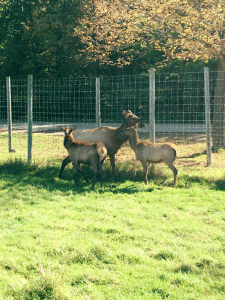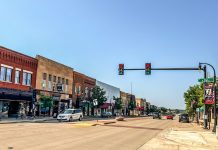Wildwood Zoo recently welcomed two new additions, two elk calves donated by Pittsview Farm Elk in Pittsville.
The calves were born this spring and weaned from their mothers about a month before coming to the zoo on September 13.
“They are the last calves from our elk farm,” said Nancy Stauner, who raises elk with her husband, Ray. “We enjoyed showing them at our farm. Now I can visit them with everyone else, still.” She said she’ll miss raising the elk, but knows that they will be well taken care of at the zoo.
 Zookeeper Steve Burns was introduced to the couple through Laura Johnson, who donated white-tailed deer Desti and Graci in 2015. “That’s something we really appreciate,” he said of animal donations.
Zookeeper Steve Burns was introduced to the couple through Laura Johnson, who donated white-tailed deer Desti and Graci in 2015. “That’s something we really appreciate,” he said of animal donations.
The elk’s pasture can be located by foot or car. “If you are walking from the zoo, they would be in the first pasture you come to,” said Burns. “If you’re driving around the upper pond drive, they would be in the last.”
Rocky Mountain Elk are native to North America and were historically found throughout Wisconsin. In 1995, the Department of Natural Resources reintroduced 25 elk to the Clam Lake area and recently established more wild elk in Black River State Forest with a long-term population goal of 390.
“Our population size we like to try to keep around eight elk,” said Burns. “We were getting toward the lower end, so we just wanted to supplement that population.” They are fed Purina deer chow, a commercially made pellet diet, and naturally graze in their pasture.
The new arrivals were quickly greeted by the other elk.
“We had a little more of an introduction planned. However, shortly after their arrival the calves decided to introduce themselves,” laughed Burns. “The introduction went great. One of the cows immediately accepted them and has taken them in.”
In the winter, the elk stay in the same pasture and benefit from two three-sided shelters with straw bedding. High-quality hay is donated from the University of Wisconsin Research Station, which Burns said has been an awesome relationship for the zoo.
Occasionally the zoo’s bull, named Lincoln, will drop one of his large antlers. This year, his antlers were auctioned off at the Be the Bunny event in mid-April, while others are kept by the zoo.
“We keep one good set for education so when we do tours, we got a set of antlers to show kids,” Burns said, adding that the zoo gets a lot of inquiries about buying the antlers. They remain a good fundraising opportunity for the zoo.
October being the tail end of breeding time for the elk, visitors can witness Lincoln bugling toward the cows in the next week. For now, the bull is separated from the three cows.
“It’s a neat time of year,” he said.
















